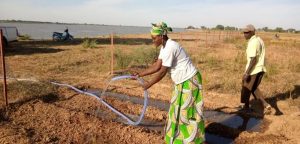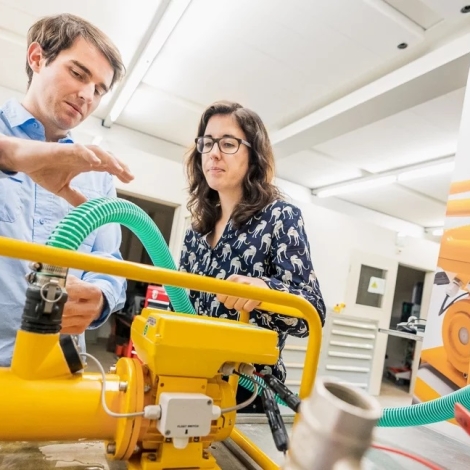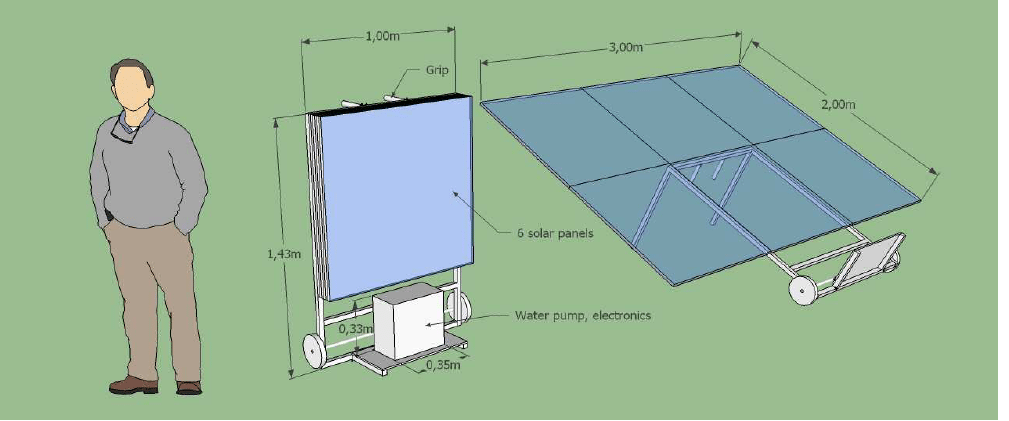Gathoni Mwenja has a family livestock farm in Nairobi, Kenya, where she tends at least 30 cows. The farm on the western edge of the Horn of Africa is enduring the region’s worst drought in 40 years, pushing 18 million people into hunger. Through that natural disaster, Ms. Mwenja has struggled to sustain a constant supply of water for her animals and vegetables.
Not so long ago, she did it with the help of a diesel-powered irrigation pump. However, a working farmer in her region typically earns around KES 47,400 (USD $394.18) per month, and by mid-2020, fuel prices in Nairobi were double the farm’s net profit. Ms. Gathoni could no longer continue traditional fossil-fuel-powered irrigation. The answer to her problems was to acquire a solar pump.
Ms. Gathoni’s experience is one of the success stories of Ennos, a Swiss company committed to developing affordable pumping technologies. Its flagship product, the two-horespower sunlight pump, has a growing presence in African and Latin American countries.
 The advantages and disadvantages of this solar pump were recently analyzed during World Water Week (WWW). In a panel discussion broadcast online, Karin Jeanneret, CEO of the venture, explained how her project has managed to improve the quality of life for many people, increasing heir access to water.
The advantages and disadvantages of this solar pump were recently analyzed during World Water Week (WWW). In a panel discussion broadcast online, Karin Jeanneret, CEO of the venture, explained how her project has managed to improve the quality of life for many people, increasing heir access to water.
“The 2HP sunlight pump works with multiple photovoltaic panel configurations, from 60 to 128 Vmpp [maximum powerpoint voltage]. However, thanks to the high efficiency of its motor, it needs fewer of them compared to its competitors for the same performance,” Ms. Jeanneret says.
ENNOS, invited to WWW as an example of the expansion of the private solar irrigation pumps market, claims that its equipment can operate maintenance free, for more than ten years. The technological device has high strength and power. According to its developers, these characteristics allow a wide range of flow and pressure, and can be used in combination with drip and sprinkler systems. The 2HP pump is fully automated, as it starts up on its own when sunlight hits the solar panels, and it can be monitored remotely through an Android app.
“The design is entirely our own, however, it is assembled by Jain Irrigation Systems Ldt. This is an Indian company that has helped us expand our potential. Not only do they manufacture the pumps, they also make solar panels, drip irrigation systems and customized sprinklers,” Ms. Jeanneret said on the WWW panel.
See the Drip Kit with Solar Pump by Jain Irrigation Systems in E4C’s Solutions Library
ENNOS also seeks to change the productive capacities of smallholder farmers. The performance of family farms is usually low, but ENNOS aims to improve their results with an eminently feminist approach.
 “In most cases, women and girls are responsible for fetching water for drinking and household use, a task that often involves long and strenuous walks. With the solar light pump they now have more time to devote to other tasks. It also opens up the possibility for them to become entrepreneurs and increase their income by providing water pumping services to the community,” Ms. Jeanneret says.
“In most cases, women and girls are responsible for fetching water for drinking and household use, a task that often involves long and strenuous walks. With the solar light pump they now have more time to devote to other tasks. It also opens up the possibility for them to become entrepreneurs and increase their income by providing water pumping services to the community,” Ms. Jeanneret says.
One example of this is a women’s cooperative that has been using the solar irrigation pump since 2017. Through their work system, everyone benefits from its use, and by splitting the costs, the financial pressure is low. These entrepreneurs report that this is possible thanks to the lightweight and mobile nature of the solar light pump.
Unmet potential
The WWW panel on solar irrigation also delved into the problems linked to this type of technology, mainly in Africa. Claudia Ringler, a member of the International Food Policy Research Institute, said that the uptake of solar power systems has been very slow, even where governments provide high subsidies.
“Solar irrigation dealers have a lot of barriers, such as lack information and awareness of farmers, the cost of solar PV compared with other pumps, lack of financing, fake products, land area requirements, and others,” Ms. Ringler says. According to her presentation, only around 50,000 solar pumps are thought to have been sold across Sub-Saharan Africa for irrigation.
 “Sub-Saharan Africa has a quarter of the world’s farmland but produces only about 10 percent of its agricultural output. Africa’s full potential can increase 2-3 times more with investment in solar equipment,” Ms. Ringler says.
“Sub-Saharan Africa has a quarter of the world’s farmland but produces only about 10 percent of its agricultural output. Africa’s full potential can increase 2-3 times more with investment in solar equipment,” Ms. Ringler says.
Another concern is that many people still do not understand the scope of the applications of sunlight-powered pumps. So far, their applications have been limited to agriculture and livestock. Applications that are thus far untapped on a large scale are aquaculture and bottling and selling water, to name two examples. The expansion of these largely unexplored kinds of uses will provide disadvantaged populations with greater resilience, and will enable them to mitigate and adapt to climate change, according to the experts on the WWW panel.
About the Author
Claudia Alemañy Castilla is the 2022 Engineering for Change Editorial Fellow and an award-winning journalist who splits her time between homes in Cuba and Spain. Among her accomplishments, Ms. Alemañy Castilla has developed the COVID-19 Cuba Data Project for Juventud Técnica Magazine in Havana, Cuba, where she was a staff reporter specialized in science, technology and environmental journalism. She has also reported for Women in Science (a publication of País Vasco University), the Cuban Institute of Cultural Research ‘Juan Marinello,’ and others.


Corrected. Thank you!
I really hope she didn’t say “60 to 128 Volts per minute” which is obviously nonsense – could you correct it with a meaningful number please.
What villagers need is technology know-how and finance. They can buy such systems and use locally available sunshine, and water. With support from government and in cooperation with urban businesses, they can do good to the society and themselves.
They can set up solar PV panels on public and private lands and generate electrical energy. Use that energy to lift water from wells. Such water can be used for domestic and commercial purposes.
They can use the electricity to charge reversible fuel cells.
By using electricity and water, they produce green hydrogen.
Every village near a highway can become a ready supplier of bottled water, green hydrogen, fuel-cells to motorists.
The Internet can be a good aid to communicate the needs and supplies of these commodities.
Good morning .
Am active farmer, ready to venture into serious farming, with the increased fuel cost it is becoming difficult.
Assist, advise